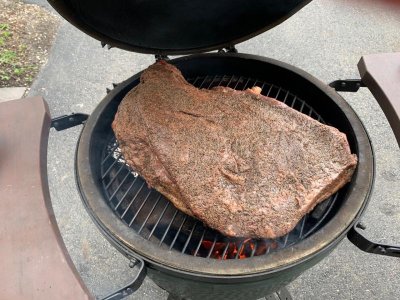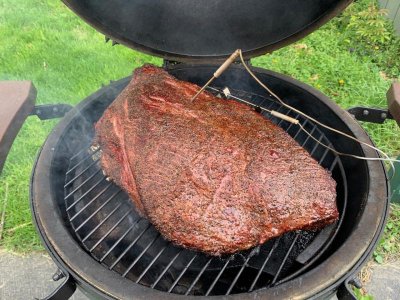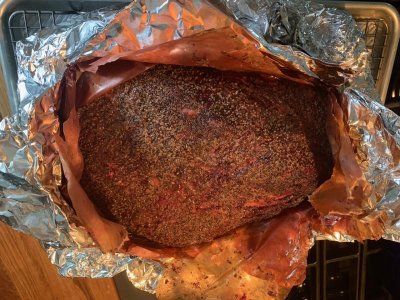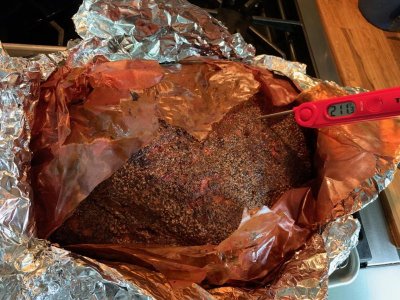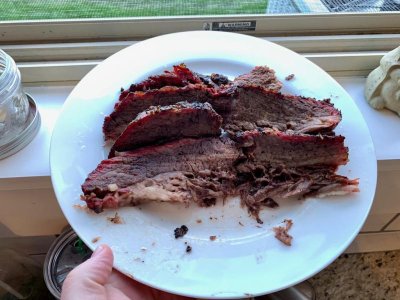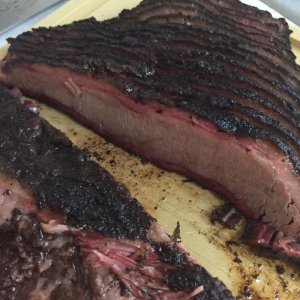Looks great for a second attempt. I used to wrap mine, but found I liked the bark better if I didn't wrap at all.
As for slicing, here's what I wrote in my brisket document:
Slicing:
- I separate the point from the flat and set it aside. Just slide a knife between the two muscles and it should easily come apart.
- I find my notched corner (I notched one of the corners when I was trimming the fat to make it easy to know which way the grain was running) and start slicing the flat in 1/4" slices against the grain. Depending on the size of the brisket, I may cut the widest part of the flat in half and then go back to slicing. Great size for tacos and no one wants the slice dangling off the edges of the plate.
- For the point, I flip it over and find the grain. Again, I will cut this in half with the grain and then make slices against the grain.
- The thin outer edges may crumble a bit. This is ok.
The whole document, which I learned from here, can be found below.
I am by no means a brisket master, but here is what I do:
Shopping for the brisket:
- Here in SoTex, we have access to cheaper briskets. I watch for Primes to go on sale and buy a couple of them at around $3 a pound.
- I shoot for somewhere in the 14-16 pound range.
- I will go through every brisket they have picking them out. I look for a brisket that has a thick flat and a thick point. It might make it more narrow, but less chance of drying out.
- I love a nice, floppy brisket. Grab it from one end and shake it up and down and see how "loose" the meat is. The last one I bought would easily fold over on itself and sit on the counter that way.
Planning:
- Briskets take a LONG time to cook. And two 14 pound briskets may be done hours apart from each other. Plan accordingly. I like to plan for 1.25 hours per pound, a couple hours for resting, and I'll usually throw in another hour or two in case things go sideways. There is nothing worse than a starving family asking if it's done yet.
Prepping the brisket:
- I have done the heavy trimming and no trim at all. I used to prefer somewhere in the middle. I would trim the fat cap to 1/4" or so, but not too picky about it. Lately, I have found that the more aggressive I trim, the more smoke ring I get. Been trimming them almost as close as those you see for competitions and getting a ring finally. I do try to get rid of as much of the thick, usually yellowish, hard fat that is between the muscles. This won't render and is just bad stuff.
- I like to look at the bottom side of the brisket and see which way the grain is running on the flat. I will notch the corner against the grain so when it's ready to slice, I know from which end to start.
- Once trimmed, I throw the brisket in the sink or a pan and give it a good rub down with Worcestershire sauce or olive oil. I sprinkle heavily with Kosher Salt. I want to see the crystals. It's a thick cut of meat and can use the salt. I sprinkle even heavier in black pepper, just because that's the way I like it. I also add a little onion powder and garlic powder. Those four spices together are usually known as SPOG. If I am feeling adventurous, I might sprinkle a little Chipotle powder or paprika. I like to wrap the brisket up in Saran wrap and let it rest for a couple hours or overnight in the fridge, but it can go right to the smoker at this point.
On the smoker:
- I have a Lone Star Grillz Insulated cabinet, but have cooked these on a vertical offset too. I typically call for letting the smoker run where it's comfortable. My WSM liked 275*. My cabinet prefers 250*, but with a Guru attached, I usually do an overnight cook and start out at 225*, and then crank it up to 275* in the morning. I use KBB and add some Mesquite and Pecan chunks.
- Once I get the smoker fired up, Guru blowing, and doors closed, I go get the cold brisket out of the fridge, unwrap it and put it on. I have found that putting the cold meat on while the smoker is still coming up to temp has provided more of a smoke ring. I don't know the science behind it, but it works for me.
- I have tried fat cap up and fat cap down. No real difference on my smoker. I will say that no matter which way I place it, the outside of the meat on the opposite side of the fat cap always seems to get a little crusty. Not a lot, not bad, just takes a little work to slice through. Still tastes great. I am still working on that.
- Again, low and slow (225*) overnight, and then I crank it up to 275* in the morning. I used to wrap in foil on my WSM. I bought a roll of Kraft paper to try wrapping that way, but never got around to it. Since I got this cabinet, I started letting them ride nekkid the whole way and I found that I like it better that way.
- I don't cook by time or temp, but I do follow the temp. The brisket is done when I can shake it and the point jiggles like Jello and when a wooden chopstick pushes easily through the thickest part of the flat.
Off the smoker:
- When done smoking, I pull the meat off and set it on the counter for 10 to 15 minutes to rest and let the residual heat die down and stop cooking.
- After that rest, I will wrap it in foil, wrap it in an old towel, and put it in a cooler. If I am feeling lazy, I'll just put it in the cool oven. There's enough heat still that it will warm the oven up and keep it that way for a couple hours. I leave it to rest like this for at least an hour, but two is better. We did a benefit where we held the briskets in coolers for 10+ hours and they were still burning my fingers when I pulled them out.
Slicing:
- I separate the point from the flat and set it aside. Just slide a knife between the two muscles and it should easily come apart.
- I find my notched corner and start slicing the flat in 1/4" slices against the grain. Depending on the size of the brisket, I may cut the widest part of the flat in half and then go back to slicing. Great size for tacos and no one wants the slice dangling off the edges of the plate.
- For the point, I flip it over and find the grain. Again, I will cut this in half with the grain and then make slices against the grain.
- The thin outer edges may crumble a bit. This is ok.
The test:
- A slice of the flat should be able to be tugged gently from both ends, you'll see it stretch a bit, and then break in two.
- You should be able to lay a slice of the flat on the cutting board, fold it over on itself, and it should stay like that without unfolding back or breaking in half.
- Gently pushing down on the meat should cause some juices to run out.
The general rule is as follows:
The brisket is tough and dry - Undercooked
The brisket is falling apart and dry - Overcooked
The brisket is tender and juicy - CONGRATS!

